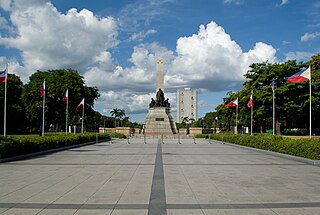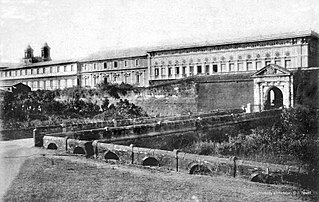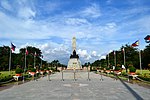
Metropolitan Manila, commonly shortened to Metro Manila and formally the National Capital Region, is the capital region and largest metropolitan area of the Philippines. Located on the eastern shore of Manila Bay, the region lies between the Central Luzon and Calabarzon regions. Encompassing an area of 636.00 km2 (245.56 sq mi) and with a population of 13,484,462 as of 2020, it consists of sixteen highly urbanized cities: Manila—the capital city—Caloocan, Las Piñas, Makati, Malabon, Mandaluyong, Marikina, Muntinlupa, Navotas, Parañaque, Pasay, Pasig, Quezon City, San Juan, Taguig, and Valenzuela, along with one independent municipality, Pateros. As the second most populous and the most densely populated region in the Philippines, it ranks as the 9th most populous metropolitan area in Asia and the 6th most populous urban area in the world.

Manila, officially the City of Manila, is the capital and second-most populous city of the Philippines, after Quezon City. Located on the eastern shore of Manila Bay on the island of Luzon, it is classified as a highly urbanized city. Manila is the world's most densely populated city proper, with 43,611.5 inhabitants per square kilometer (112,953/sq mi) and a population of 1,846,513 people in 2020; it is also the historic core of a built-up area that extends well beyond its administrative limits and includes some 24 million people. Manila was the first chartered city in the country, designated by Philippine Commission Act No. 183 on July 31, 1901. It became autonomous with the passage of Republic Act No. 409, "The Revised Charter of the City of Manila", on June 18, 1949. Manila is considered to be part of the world's original set of global cities because its commercial networks were the first to extend across the Pacific Ocean and connect Asia with the Spanish Americas through the galleon trade. This marked the first time an uninterrupted chain of trade routes circling the planet had been established.

Intramuros is the 0.67-square-kilometer (0.26 sq mi) historic walled area within the city of Manila, the capital of the Philippines. It is administered by the Intramuros Administration with the help of the city government of Manila.

Gomburza, alternatively stylized as GOMBURZA or GomBurZa, refers to three Filipino Catholic priests, Mariano Gómes, José Burgos, and Jacinto Zamora, who were executed by a garrote on February 17, 1872, in Bagumbayan, Philippines by Spanish colonial authorities on charges of subversion arising from the 1872 Cavite mutiny. The name is a portmanteau of the priests' surnames.

Paco, formerly known as Dilao, is a district of Manila, Philippines, located south of the Pasig River and San Miguel, west of Santa Ana, southwest of Pandacan, north of Malate, northwest of San Andres Bukid, and east of Ermita. According to the 2020 census, it has a population of 79,839 people.

Rizal Park, also known as Luneta Park or simply Luneta, is a historic urban park located in Ermita, Manila. It is considered one of the largest urban parks in the Philippines, covering an area of 58 hectares. The site on where the park is situated was originally known as Bagumbayan during the Spanish colonial period. It is adjacent to the historic Walled City of Intramuros.

Malate is a district of Manila, Philippines. Together with the district of Ermita, it serves as Manila's center for commerce and tourism.

The Manila North Cemetery is one of the oldest cemeteries in Metro Manila, Philippines. The cemetery is owned by and located in the City of Manila, the national capital, and is one of the largest in the metropolis at 54 hectares. It is located alongside Andrés Bonifacio Avenue and borders two other important cemeteries: the La Loma Cemetery and the Manila Chinese Cemetery. Numerous impoverished families notably inhabit some of the mausoleums.

The gates of Intramuros refer to the original eight gates of the Walled City of Intramuros in Manila, built during the Spanish colonial era in the Philippines. The gates are called by the original Spanish word for "gate", puerta.

The Rizal Monument is a memorial in Rizal Park in Manila, Philippines built to commemorate the executed Filipino nationalist, José Rizal. The monument consists of a standing bronze sculpture of Rizal, with an obelisk, set on a stone base within which his remains are interred, holding his 2 famous novels "El Filibusterismo and Noli Me Tangere". A plaque on the pedestal's front reads: "To the memory of José Rizal, patriot and martyr, executed on Bagumbayan Field December 30 1896. This monument is dedicated by the people of the Philippine Islands."

José Protasio Rizal Mercado y Alonso Realonda was a Filipino nationalist, writer and polymath active at the end of the Spanish colonial period of the Philippines. He is considered a national hero of the Philippines. An ophthalmologist by profession, Rizal became a writer and a key member of the Filipino Propaganda Movement, which advocated political reforms for the colony under Spain.

Padre Burgos Avenue, also known as Padre Burgos Street, is a 14-lane thoroughfare in Manila, Philippines.

In Metro Manila, Philippines, tourism is a significant industry. In 2012, the city and the region welcomed 974,379 overnight visitors. Serving as the main gateway to the Philippines' numerous destinations, the city attracts mainly international tourists, with a total of 3,139,756 visitors in 2012. Global Blue ranks Manila as the eleventh 'Best Shopping Destination' in Asia. The city holds the tenth position in MasterCard's global top 20 fastest-growing cities for international visitors from 2009 to 2013.

The Battle of Manila of 1896 occurred in Manila in the Spanish colony of the Philippines during the Philippine Revolution. Katipunan under Andres Bonifacio attempted to take the city but the attempt failed, and Bonifacio retreated to the city's outskirts. The Battle of San Juan del Monte was joined a day later when Bonifacio attempted to capture the San Juan's powder magazine, but this too failed.
The Iglesia Watawat Ng Lahi, Inc. is a socio-folk religious group based on Lecheria Hill in Calamba, Laguna, Philippines which believes in the divinity of José Rizal, a historic figure of the Philippine Revolution. It is often considered as the original Rizalist group among the many other Rizalista religious movements.

Ildefonso Paez Santos Jr., popularly known simply as "IP Santos", was a Filipino architect who was known for being the "Father of Philippine Landscape Architecture." He was recognized as a National Artist of the Philippines in the field of Architecture in 2006.

The following is an alphabetical list of articles related to the Philippine capital region of Metro Manila.

Greater Manila, officially the City of Greater Manila and sometimes referred to as the Greater Manila Area (GMA), was a chartered city that existed during the Japanese occupation of the Philippines in World War II, from 1942 to 1945. Governed by the Commonwealth of the Philippines, it served as a model for the present-day Metro Manila and the administrative functions of the governor of Metro Manila—both established three decades later during the administration of President Ferdinand Marcos. It was a merger of Manila, Quezon City, and the then-Rizal towns of Caloocan, Makati, Mandaluyong, Parañaque, Pasay, and San Juan, all present parts of Metro Manila.

The National Parks Development Committee (NPDC) is an agency of the Department of Tourism (DOT) of the Philippines that is mandated to develop, preserve, and manage Rizal Park (Luneta) and Paco Park in Manila and other parks that may be assigned to it. Its main office is located in the Old Planetarium Building, Padre Burgos Avenue, Rizal Park, Ermita, Manila. Both the Executive Director and the Deputy Executive Director are appointed by the President of the Philippines.

The Gomburza National Monument is a bronze monument in the Philippines dedicated to the three Catholic martyr-priests Fathers Mariano Gomes, Jose Burgos and Jacinto Zamora who were executed via garrote by the Spanish colonial authorities in 1872 on charges of subversion arising from the 1872 Cavite mutiny.




























